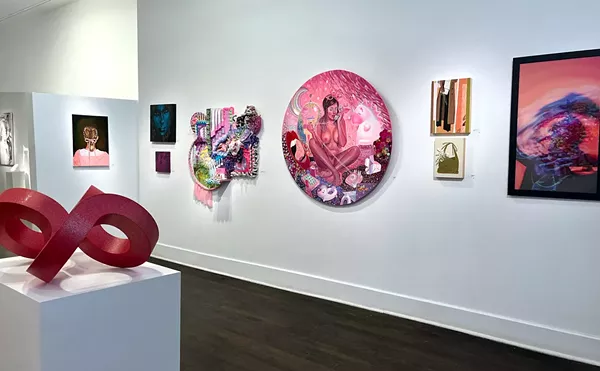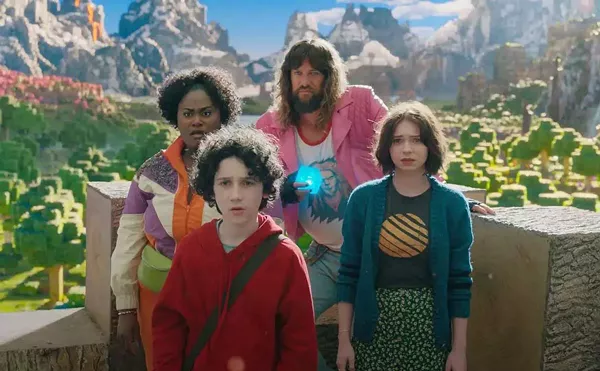
Audio By Carbonatix
[
{
"name": "GPT - Leaderboard - Inline - Content",
"component": "35519556",
"insertPoint": "5th",
"startingPoint": "3",
"requiredCountToDisplay": "3",
"maxInsertions": 100,
"adList": [
{
"adPreset": "LeaderboardInline"
}
]
}
]
Cooper Holoweski's series of large-scale prints, "Mediations on Colonization," results from weeks of trial and error; a process that almost defies progress, one not limited to erasing, layering, tearing down and rebuilding. Basically, Holoweski creates something, screws it up, does it again, repairs it (maybe), and spreads out to conquer more canvas.
There's method to this guy's mad plotting. In his solo show at Pontiac's Museum of New Art — tellingly titled Boom and Bust — Holoweski peels back the layers of history, highlighting worldwide trends of imperialism and colonization through centuries. And he reflects on the American political system that allows and even encourages misinformation.
Mistakes don't freak him out. He uses them to prove his point. With degrees in printmaking and political science from the University of Michigan, Holoweski is curious about errors made by machines and at the hands of humans — be it a black-and-white printer or the "democratic" system. His prints are loose allegories about ways people live in their environment — what writer and filmmaker Guy Debord called "psychogeography."
The five mixed-media prints of "Meditations in Colonization" look like fractured landscapes. When squinting from a distance you can see a ship barging into cavernous land or a dusty street scene from an excavated city. But he'd rather you read between the lines.
Layered thick with scraps from old atlases, grids printed on architectural vellum, cut-up photos and original charcoal drawing, he blurs distinctions between the past and the present because history repeats itself. He Xeroxes a photo of a scanned map until the image is so fuzzy it's nearly indecipherable from a charcoal drawing. When it comes to centuries' worth of world events, is it possible to differentiate what really happened from a carefully constructed version of it? At what point in time exactly does the truth turn into interpretation?
Attempting to read his work as if they are actual maps is impossible; you might find Mexico City smack in the middle of Montana. Holoweski's geographic references are universal. "It's about wealth and development and the baggage that goes along with it in any city," he says. (The Ypsilanti-based artist even includes references to Detroit streets, including Euclid, Howard and others.)
Maybe that's where the show title comes in: Boom and Bust referring to the explosion of capitalism that shot across the globe after World War II, when the United States, with Western Europe and Japan, emerged as superpowers. This new imperialism, insidiously indirect, is now on the brink of busting.
It would be impossible and pretty unrewarding to read into everything Holoweski lays down — he admits bits of the collage are just for looks — but close inspection can pay off.
In the fourth piece of the series, for example, he uses photomontage — a process traditionally favored by politically bent dadaist artists — to construct potent visual sentences about European colonialist propaganda. Stacking old black-and-white photos of architecture and public sculpture (lifted from arbitrary editions of Collier's magazine), the montages read like CliffsNotes about the way a government rules the land through pompous and intimidating design.
In one toppling montage, a castle's turret is glued on an 18th century Greek revivalist doorway. It recalls philosopher Walter Benjamin's belief that disparate architecture butting up against each other can be a great lesson of where we've been and where we're going. Just a few inches over, a bulky 20th-century building is not too great or heavy to sit proudly on a horse — replacing the western European rider — emphasizing the point that early 20th century architecture advanced the pace of modern life dramatically.
Infrastructure, whether we're talking about the network of capitalism or telecommunications, rules the contemporary world. Upstairs at MONA also hangs "Power I" and "Power III" — mixed-media collages on wood, in which cell phone towers divide a natural landscape. The background buzzes with names and numbers from the Yellow Pages. Their arrangement slices the picture plane, cutting the atmosphere like jagged shards of a broken mirror, reflecting a society where all private information is public.
Downstairs, earlier work tells the story of how this young artist has evolved into using maps as material. With our current political situation, maps as art is popular. (For one other good example, see Chicago-based artist Brian Dettmer, who uses a Sharpie to eliminate any words etymologically linked to the Arabic language, proving the power of the Middle East does not rest solely in the region "over there.")
It's refreshing to see that Holoweski's work traveled its own path from the traditional toward the conceptual. You can see this transformation. In his early "Ether" series of prints of high-rise buildings, the sky vibrates the same way it does in his later "Power" series, except this time, the energy rises from ink splatter marks and scrapes instead of cut-up text.
Continuing his evolution, the charcoal-and-pencil "Empire Drawings" range from minimal connect-the-dots-style sketches to full-blown graphite explosions of billowing clouds, rough shapes and dark lines. It's as if he catalogued a creative breakthrough — the notion to move beyond architecture into abstraction is bursting forth, burning a hole in the paper.
"I have something in me as a printmaker. The printmaker in me always wants to fuck something up."
While looking at his work, you're subjected to a slow screeching sound that rises from a big bus halting in the corner of the room. Holoweski's not content to stick to one medium; he also composes films as moving paintings. The "Homeland" video that runs during Boom and Bust is a torturous 16-minute show of bumper-to-bumper traffic in Las Vegas, which he shot by duct-taping a camera to the hood of his rental.
"I wanted to do something to this video," he says. "I tried everything: filtering, splicing ... nothing was working." All he had to do, it turns out, was slow the future city down by 40 percent, so we can meditate on big, bright, bawling, materialistic distractions.
Boom and Bust: Works by Cooper Holoweski runs through July 24 at Museum of New Art (MONA), 7 N. Saginaw, St., Pontiac; 248-210-7560.
Hosting & posting
Holoweski leaves for Rhode Island School of Design in the fall, but stay connected through his site astronautcollective.com. Artists worldwide can sign up anonymously to participate in producing an edition of an online magazine. Here's how it works: Each month or so, you'll receive an e-mail directing you to create an artwork at a specific date and time. All the work is posted as a collaborative publication, an example of how people can work together to generate something complex and beautiful. It's also a record of all the creativity that happened simultaneously. It, too, like the rest of Holoweski's ideas, hums, as he develops small ideas into something bigger.
Rebecca Mazzei is Metro Times arts and culture editor. Send comments to letters@metrotimes.com




